talkingfashion » fashion blog
-
Faith & Fashion
Faith & Fashion by Morgan Watkins
Although styling looks with religious jewelry is not a new concept, it seems to be having a major moment in the fashion universe. The latest Heavenly Bodies Met Gala and exhibit resulted in looks so exquisitely sultry, it should be a sin. But what are the true origins of Catholic inspired fashions, Christian cross necklaces and other religious dressings that have been commodified for the general public to wear? Keep reading to learn more about religious jewelry.The Cross

Cross necklaces have been a symbol of faith for followers of Christ since the times of the Roman Empire in the 4th century. Not only does this powerful accessory show Christian, or Catholic, faith, but it also serves as a form of spiritual protection for the wearer. These necklaces can also be gifted to individuals at baptisms and confirmation ceremonies, with simple crosses or embellished ones showcasing diamonds and even birthstones. For decades, the spiritual significance associated with cross jewelry has faded as icons in pop culture, like Madonna and Billy Idol, have turned the spiritual items into fashion fads. Cross necklaces have also been worn in political contexts to criticize popular religious beliefs that work towards shaming women for their individuality and sexuality. But no matter the rhyme or reason for wearing necklaces with hanging crosses, a lot can be said about their staying power in the fashion world. Paired beautifully with delicate lace, cross necklaces can create a look so stunning, you’ll be in heaven.
Prayer Jewelry

(Image from https://www.malaprayer.com/blogs/news/everything-you-need-to-know-about-mala-pray er-necklaces)
Prayer jewelry quite possibly holds even more religious significance than cross necklaces, and have not been brought into mainstream fashion as a superficial accessory. Various religions hold onto beaded necklaces representing various purposes. Islamic prayer beads typically have 100 beads, while those of the Baha’i religion have 95 or 19, with a grouping of 5 beads hanging below. Sikhs, Hindus and Buddhists wear what are known as mala prayer necklaces, which are worn not only around the neck, but also around turbans and wrists. Malas typically have 108 beads made of natural materials like sandalwood and lava stone, and are said to have originated in India during the 8th century. Mala became popular in countries like China, Korea and Japan before hitting Europe during the late Middle Ages in the shape of the Catholic rosary. Roman Catholics, like most other religions utilizing prayer beads, used rosaries to count prayers and other acts of worship, as well as provide security. These necklaces characteristically feature 59 beads, but before beads came around, a popular way of keeping track of prayers was by tying knots or fastening berries, pebbles and/or bone discs onto necklaces.
Fita do Senhor do Bonfim

(Image from http://www.sensationalcolor.com/color-meaning/color-meaning-symbolism-psychology/b ahia-bands-brazilian-wish-bracelet#.W7-v8WhKhaQ)
Similar to prayer necklaces, Fita do Senhor do Bonfim, or ribbon of Bonfim, are essentially wish ribbons. Dating back to 1809, the ribbons, also known as Bahia bands, were originated by the African religion of Cadomblé. They were initially called “measure of Bonfim” because their size equated the length of the arm of the Jesus Christ statue perched upon the main altar of the Bonfim Church in Salvador, Brazil. Measuring 47 centimeters long, Bahia bands are commonly worn around the left wrist, on the ankle, around hats and necks, and are even tied to the gate of the Bonfim Church. When tied in three knots, a wish can be made. Customarily, the ribbon is gifted to an individual and is tied to the receiver’s wrist by the gifter. The band must fall off the body naturally over time, or the wish will not come true. These accessories also represent good faith, and the color of the band symbolizes specific orixás, or divine forces of nature. For instance, the color red represents passion and strength, yellow equates to success and intelligence, and orange signifies courage, energy and joy.

Accessories like the ones mentioned above can have deep meaning for a variety of people and cultures around the world.While appreciating the artistic and aesthetic elements of religious styles in fashion isn’t a sin, it is crucial that everyone, from runway connoisseurs and everyday individuals, know and respect the rich history behind the symbols they wear.
References
Coscarelli, Alyssa. “Is It Okay To Wear Religious Symbols For Fashion?” Refinery29, 4 May 2018, https://www.refinery29.com/cross-jewelry-trend.
“Everything You Need to Know about Mala Prayer Necklaces.” Mala Prayer, https://www.malaprayer.com/blogs/news/everything-you-need-to-know-about-mal
A-prayer-necklaces.
Ribeiro, Patricia. “A Traveler’s Guide to Bonfim Church.” Trip Savvy, 30 June 2017, https://www.tripsavvy.com/bonfim-church-salvador-brazil-1467851.
Smith, Katie. “Bahia Bands: Brazilian Bracelet Color Meaning.” Sensational Color, http://www.sensationalcolor.com/color-meaning/color-meaning-symbolism-psych ology/bahia-bands-brazilian-wish-bracelet#.W7-yEGhKhaS. -
Gift Giving 101: The History of the Custom and How to Be a Good Guest
Gift Giving 101: The History of the Custom and How to Be a Good Guest
By Paige McKirahan
‘Tis the season for giving; whether you are the giver or the receiver, there is no denying that this custom is synonymous with the Christmas season. It is hard not to wonder, though, where and when this tradition began. As most traditions and customs do, this one originates in ancient Rome and is a relic of the winter solstice in December. This was celebrated in Rome with gift-giving and continued on as Christianity became more widespread. The date of Christmas was decided sometime in 330 AD and was claimed to be associated with the birth of Jesus; after this milestone, the custom was associated with the story of the Magi presenting gifts to baby Jesus. Along with that, some legends also base this idea of gift giving on Saint Nicholas, a fourth century Greek Bishop more affectionately known as Santa Claus. Presently, it is estimated that there is over $5 billion spent each day during the shopping season alone as the holiday has become somewhat commercialized.

(photo credits to clickorlando.com)
We feel that gift giving can still be personal, and love the idea of hostess gifts. This branch on the gift giving tree is a huge part of etiquette and they are appropriate for casual dinner parties, formal dinner parties, holiday events, weekend visits and housewarming events. These gifts typically are something for the home or in the instance that the event involves a meal, they tend to lean towards wine or desserts. In some countries, this is gift is obligatory and considered a second nature when visiting someone’s home.
If you’re heading to a holiday party over the next month and are scrambling for that perfect gift for your favorite hostess, TalkingFashion has you covered! From salt and pepper shakers to vintage table lighters, we have something for everyone! Head over to our décor collections and you’re sure to be the talk of the party when you walk in with one of our little white boxes!

-
Fashion’s Favorite Gifts
Fashion’s Favorite Gifts
By Paige McKirahan
Hello TalkingFashion lovers! It is finally December; since its the season of giving, we feel that there is nothing better to give or receive than the gift of fashion! If you’re one of the elves who has made a dent in their holiday purchases with our cyber sale last week, you’ve got the right idea! But if you’re like me and haven’t even came close to formulating gift ideas for your loved ones, not to fear; the perfect holiday gift inspiration is here! We have decided looked at some of our favorite fashion fanatic’s holiday gift lists and found some great ideas for the most flamboyant to the most minimalist on your list. Read on to see our top five gift ideas from the industry's finest and how you can find similar items in our store to get that quick holiday fix!
Marina Larroude, fashion director at Barneys New York, says she looking for shine this festive season.
She would love to add more sparkles to her wardrobe for the holidays; she specifically mentioned a sparkling Sonia Rykiel bag, but you can find some shimmering pieces right in our collection!
Dion Lee, women’s ready-to-wear designer, is all about giving jewelry to her loved ones.
The talented creative claims that the only purchase she's made so far this winter is a custom jewelry piece. She finds jewelry to be one of the best gifts because of its “intimate and timeless” feel. We agree, Dion!
Rickie De Sole, fashion director at W, is hoping for a new timekeeping piece this Christmas.
He claims that classic watches that go with everything are essential to ones outfit; this is proven by the fact that he's worn the same watch since college! He loves the Chanel Boyfriend style, and it has been the only piece that have prompted him to consider breaking his longstanding devotion to his current watch! Check out a similar style below!
Michelle Cordeiro Grant, founder and CEO of Lively, is all about vintage pieces with a story.
Number one on this boss woman’s list is vintage scarves or other vintage accessories from secondhand stores! She loves when her gifts have a story and a well known history as it adds new depth to any classic piece.
Tanya Taylor, Toronto-born designer, is in the market for beach-inspired fashions!
This colorful designer loves all things tropical; this ocean affintity stems from her son's name, which is palmer! Palm themed accessories and earrings are a sure to be a success under the tree this year!
To shop any of the items you see above, click on the image to buy with ease! For other gift options, head over to our collections and start checking off those items on your list!
-
History of the Watch: A Timeless Timekeeping Accessory
The Watch: A Timeless Timekeeping Accessory
By Paige McKirahan
The neverending passage of time is what that we base all of our daily schedules on; from sleep to work to the next fun party, everything runs on the basis of time. But, what is time without a timekeeping device? Without them, we would never be quite sure if were truly on time, and for chronically late people (like myself), this would create quite a problem. People found this to be increasingly troublesome and started looking for a solution; yes, clocks on the wall tell us all we needed to know, but how would we have this knowledge if we were out and about or a clock wasnt near? This question was answered with the creation of the wristwatch in the early 1800s for the Queen of Naples.
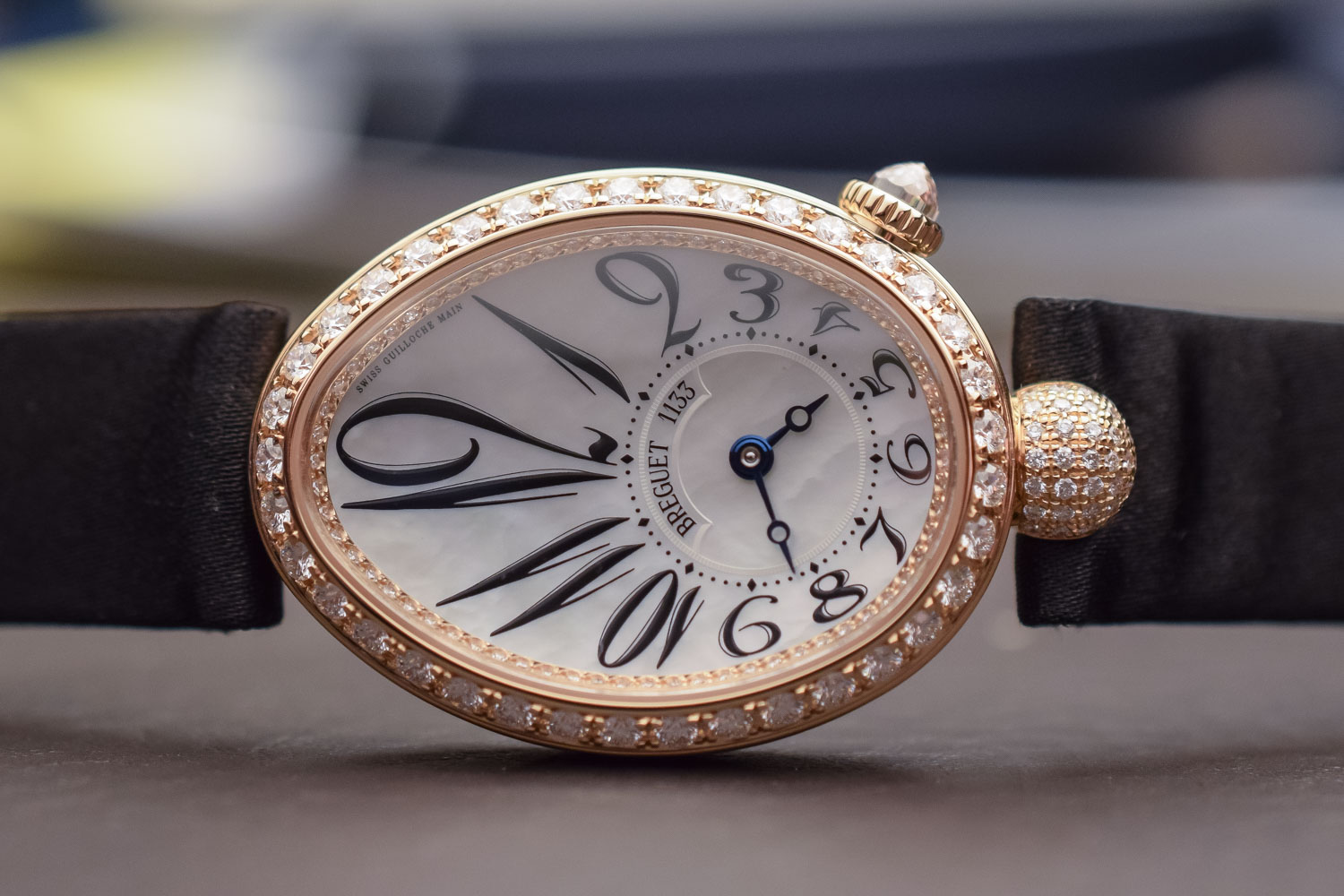
A replica of the first wristwatch
(photo credits to monochromewatches.com)
Despite the fact that arm watches were actually created in the 1570s, they were not worn on the wrist and weren't particularly popular with the public until this updated 17th century design. Arm watches were more so worn by women on account of the fact that they were prone to damage; men wore pocket watches and the first was created in 1574. Wristwatches changed this dynamic on account of the fact that men in the military advocated for the accessory as it allowed them to keep track of time with ease. Alberto Santos-Dumont, a Brazilian aviator, reached out to his friend Louis Cartier to come up with a style that of watch that would allow him to keep both hands on his controls while still being able to properly time flights. Cartier collaborated with watchmaker Edmond Jaeger to develop the Santos wristwatch, which is one of their brands cornerstone pieces.
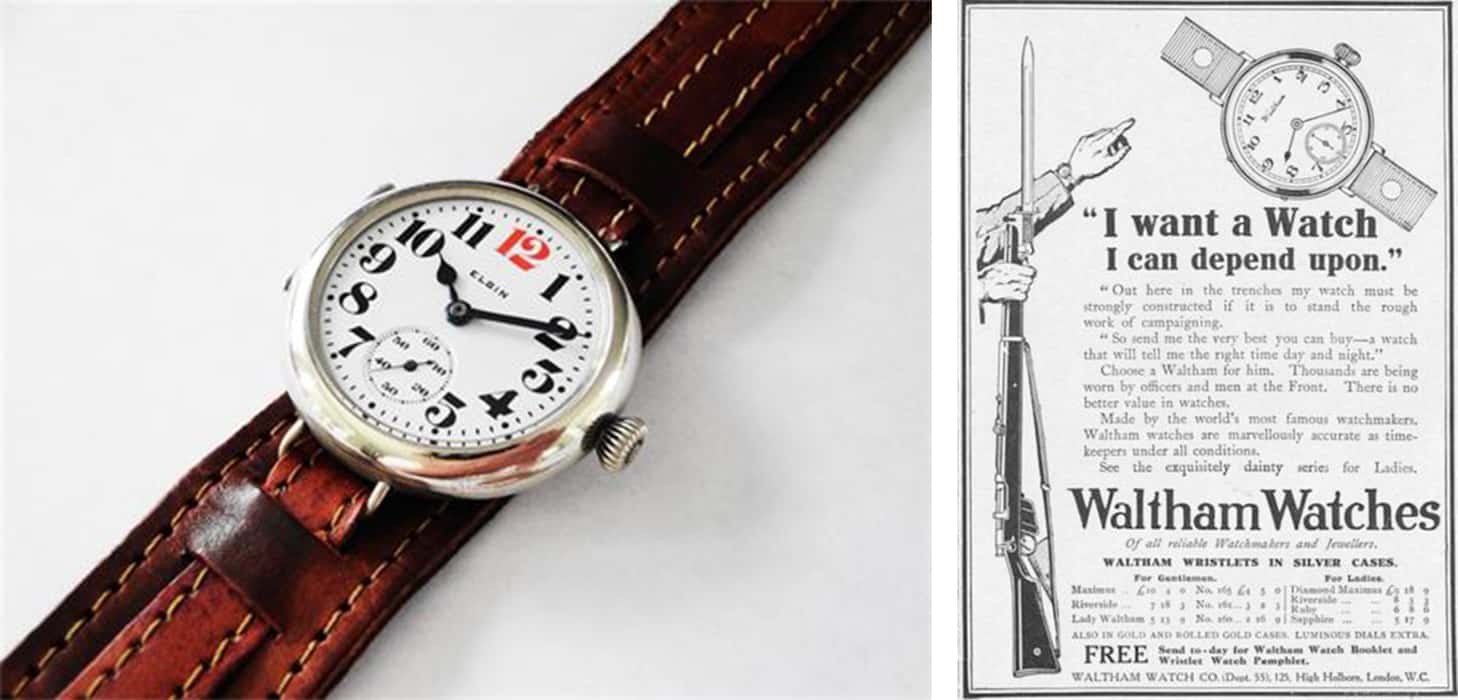
Military watch ad from WWI
(photo credits to wornandwound.com)
As we progressed towards the first World War, the popularization of watches for those in the military grew; the wristwatches they were given were referred to as “trench watches” and they established themselves as part of the Officers Kit for the war front. After this time, this accessory began to truly evolve as industrial advancements allowed for the production of wristwatches with automatic winding. John Harwood, a watch repairer, claimed patents for this ingenuity in 1923 after he was the first who managed to use the kinetic power garnered from the watches' hand movement to changing mechanisms. He then started producing these watches in a factory in Switzerland in 1928, which gave the public a chance to purchase one of his timekeeping pieces that could work for 12 hours on a full charge. In the 1950s, fully electric watches were introduced, with the balance wheel being powered by a solenoid, which is a thin wire trapped around a metallic core that procures electric currents.
This new electric watch allowed for the birth of the quartz watch, which removed all moving parts in mechanical watches; this 1969 invention instead used a battery, allowing them to be more shock absorbent and accurate without constant cleaning or oiling. Quartz watches are still manufactured today, but some luxury Swiss brands choose to create non-quartz options by hand. Today, watches can be made of stainless steel, silver, gold, titanium, carbon fibre, platinum, and aluminum. Some manufacturers even use more high tech silicons and ceramics in experimental design. Aside from regular watches, though, smart watches have made waves in wearable timepieces in the past five years and can be seen on the wrists of millions. Apple, Samsung, and Google have all created their own smart technology, opening the door for other new watches that can be connected to smart devices. Whether you are a fan of the classics or are going all digital, read on to see where your preference falls in the top 5 most iconic watches of all time!
The Cartier Santos
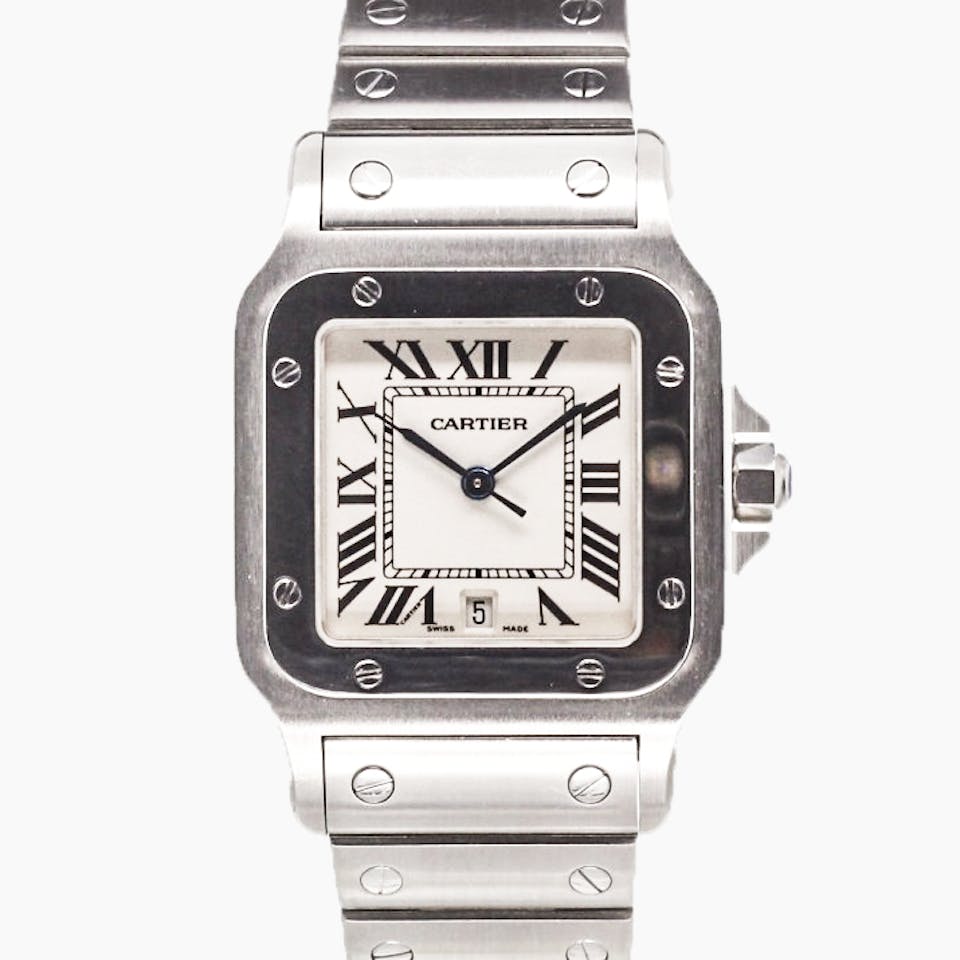
As we learned, this watch was one of the first of its kind and was created to help Alberto Santos keep time while flying his plane. Today, it is an iconic style who’s elegance and history lures in all types of buyers.
Jaeger- LeCoultre Reverso
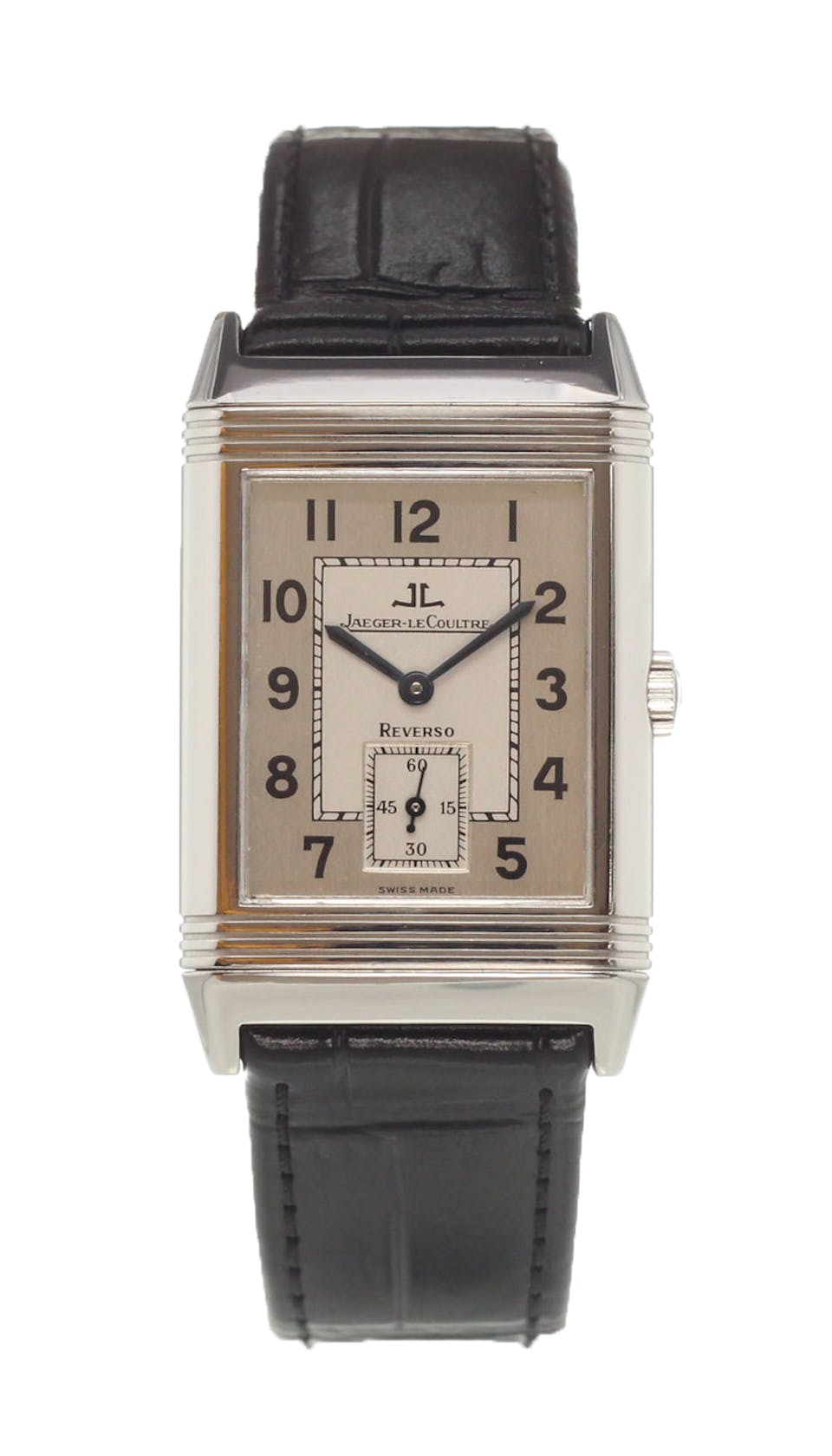
This Art Deco piece made it debut in 1931 as a watch for Britian's elite polo society. It featured a casing that was on a swivel, which ultimately protected the watch from cracks caused by force. Its classic, angular style sets it apart from the rest, appealing to collectors everywhere.
IWC Pilot’s Watch
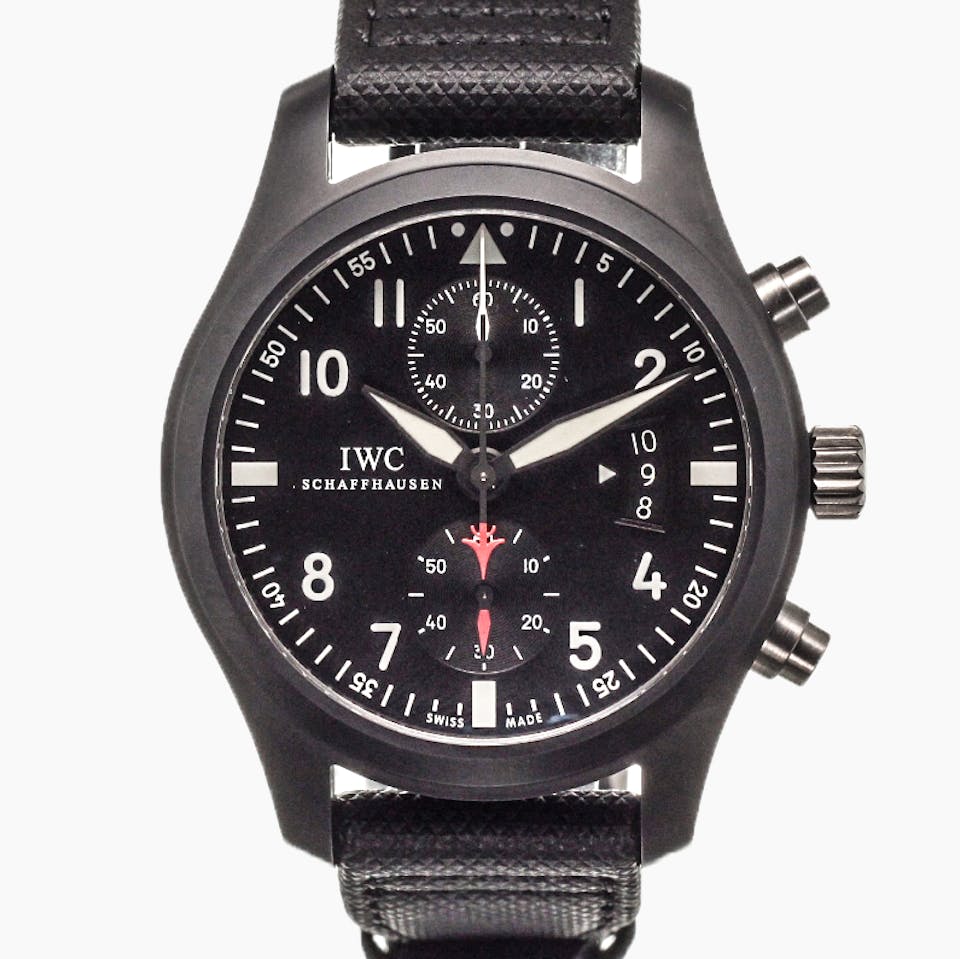
This Special Pilot's watch was the first of its kind at the time of its release by IWC in 1936; it prompted a collection of other military grade watches that captured the praise of the public for decades. This timepieces features a stainless steel waterproof casing that surrounds a softer inner cage, protecting the movement from magnetic fields.
Patek Phillippe Perpetual Calendar Chronograph

This timepiece was one of the first of its kind as it was able to keep track of the date for 200 years without adjustment. Patek released this watch in 1941 and it took the timekeeping community by storm as it was also able to measure small increments of time. Today, it is still widely sought out by collectors and leisure wearers alike.
Rolex Datejust
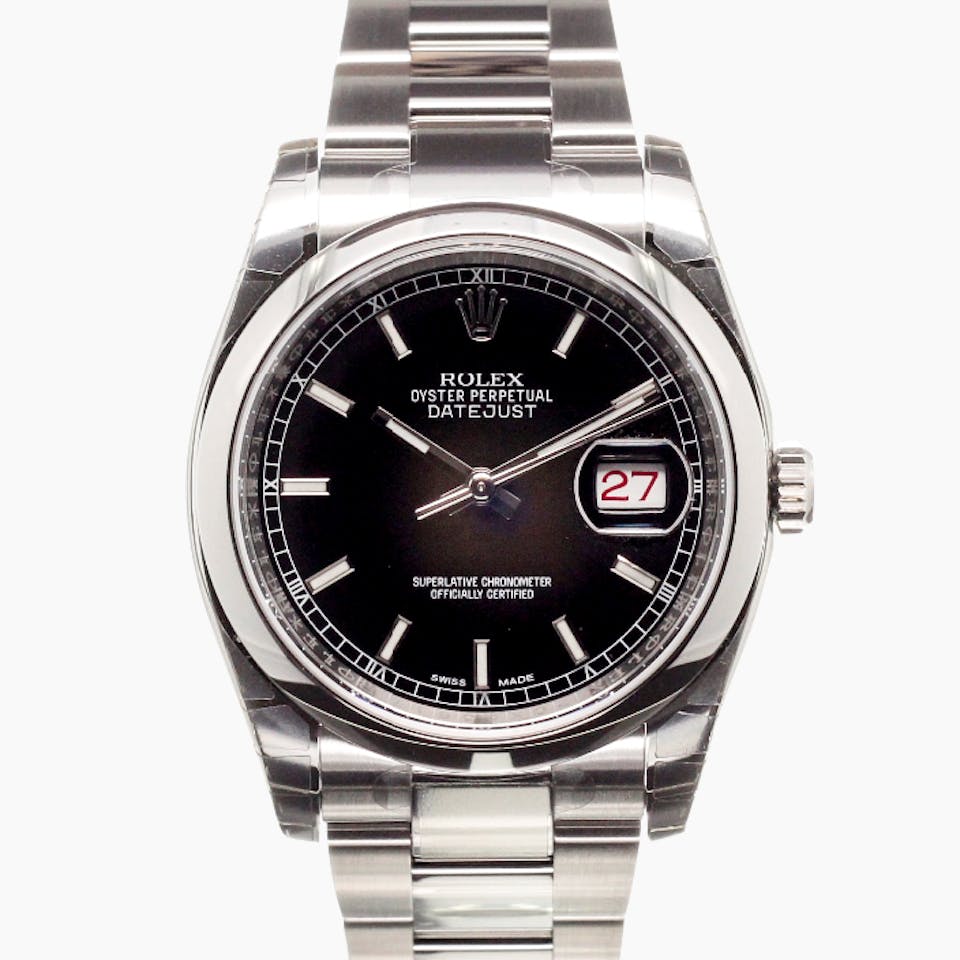
As one of the most iconic watch brands of all time, Rolex released the Datejust in 1945 and it was distinguished by its date indicator. This designs trademark was the Cyclops lense, and its original design has been nearly unchanged. A symbol of strength and intelligence, this timepiece has been worn by the likes of Winston Churchill and Dwight D. Eisenhower.
(all above photo credits to chronext.com)
If you're looking for a way to avoid being fashionably late while still being chic, check out our collection of timekeeping accessories!
-
Metallic’s Glimmering Fashion History
Metallic’s Glimmering Fashion History
By Paige McKirahan
From the eye catching metallic jumpsuits of the ‘70s to the glimmering casings of the latest iPhones, metal motifs have been loved for decades across all art mediums. As we have learned by seeing all of our mother’s fashions cycle through popular revivals, the metallic trend has come in and out of the style again and again. Though there was some metallic glamour seen in the 1930s and 40s, it wasn’t until later in the century that this style truly began to shine. Starting in the 1970s, metal moved into fashion as the disco era was in full swing; in order to shine bright under disco lights, colorful metallic clothing and accessories were essential. ABBA blazed the trail with their shimmery looks and glittering performances, but this journey was stopped short before the end of the following decade when neon in the ‘80s prevailed.

Farrah Fawcett sporting a gold dress in the 1970s
(image credits to pinterest.com)
As grungier, minimalist styles proved themselves to be on trend in the ‘90s, the early 2000s left that minimalism behind and headed towards a shining future. Both silver and gold aesthetics were the “it” styles both on the runway and in the jewelry industry. This boom happened once again in 2013 when heavy metal saturated Ready to Wear collections across the globe from Balmain to Gucci. Every color could be seen with a metallic sheen and this aesthetic was applied to everything from belts to pantsuits.
Once again, we see have this metal obsession come back into the light as these shiny styles dazzled on runway all over the world this past fall. As the trend has evolved, it is considered perfect for spring and summer looks that are fit to sparkle under the sun. But don’t think that these metal hues are just for the warm weather months; implementing darker metallic shades into a fall and winter outfit can elevate any chic cold-weather look. New Years Eve is the best time to shine and if you're looking to emulate the Times Square Ball, check out our collection for some time stopping metallic pieces perfect for any end of year celebration!













